Lunar phase
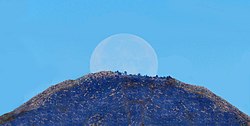
A lunar phase or Moon phase is the apparent shape of the Moon's directly sunlit portion as viewed from the Earth (because the Moon is tidally locked with the Earth, the same hemisphere is always facing the Earth). In common usage, the four major phases are the new moon, the first quarter, the full moon and the last quarter; the four minor phases are waxing crescent, waxing gibbous, waning gibbous, and waning crescent. A lunar month is the time between successive recurrences of the same phase: due to the eccentricity of the Moon's orbit, this duration is not perfectly constant but averages about 29.5 days.
The appearance of the Moon (its phase) gradually changes over a lunar month as the relative orbital positions of the Moon around Earth, and Earth around the Sun, shift. The visible side of the Moon is sunlit to varying extents, depending on the position of the Moon in its orbit, with the sunlit portion varying from 0% (at new moon) to nearly 100% (at full moon).[1]
Phases of the Moon[edit]

There are four principal (primary, or major) lunar phases: the new moon, first quarter, full moon, and last quarter (also known as third or final quarter), when the Moon's ecliptic longitude is at an angle to the Sun (as viewed from the center of the Earth) of 0°, 90°, 180°, and 270° respectively.[2][a] Each of these phases appears at slightly different times at different locations on Earth, and tabulated times are therefore always geocentric (calculated for the Earth's center).
Between the principal phases are intermediate phases, during which the apparent shape of the illuminated Moon is either crescent or gibbous. On average, the intermediate phases last one-quarter of a synodic month, or 7.38 days.[b]
The term waxing is used for an intermediate phase when the Moon's apparent shape is thickening, from new to a full moon; and waning when the shape is thinning. The duration from full moon to new moon (or new moon to full moon) varies from approximately 13 days 22+1⁄2 hours to about 15 days 14+1⁄2 hours.
Due to lunar motion relative to the meridian and the ecliptic, in Earth's northern hemisphere:
- A new moon appears highest at the summer solstice and lowest at the winter solstice.
- A first-quarter moon appears highest at the spring equinox and lowest at the autumn equinox.
- A full moon appears highest at the winter solstice and lowest at the summer solstice.
- A last-quarter moon appears highest at the autumn equinox and lowest at the spring equinox.
Non-Western cultures may use a different number of lunar phases; for example, traditional Hawaiian culture has a total of 30 phases (one per day).[3]
Lunar libration[edit]

As seen from Earth, the Moon's eccentric orbit makes it both slightly change its apparent size, and to be seen from slightly different angles. The effect is subtle to the naked eye, from night to night, yet somewhat obvious in time-lapse photography.
Lunar libration causes part of the back side of the Moon to be visible to a terrestrial observer some of the time. Because of this, around 59% of the Moon's surface has been imaged from the ground.
Principal and intermediate phases of the Moon[edit]
| Moon phase | Illuminated portion | Visibility | Average moonrise time[c] | Culmination time (highest point) | Average moonset time[c] | Illustration | Photograph (view from Northern Hemisphere) | ||
|---|---|---|---|---|---|---|---|---|---|
| Northern Hemisphere | Southern Hemisphere | Northern Hemisphere | Southern Hemisphere | ||||||
| New Moon | Disc completely in Sun's shadow (lit by earthshine only)
|
Invisible (too close to Sun) except during a solar eclipse | 06:00 | 12:00 | 18:00 | ||||
| Waxing crescent | Right side, (0%–50%) lit disc | Left side, (0%–50%) lit disc | Late morning to post-dusk | 09:00 | 15:00 | 21:00 | 
| ||
| First quarter | Right side, 50.1% lit disc | Left side, 50.1% lit disc | Afternoon and early night | 12:00 | 18:00 | 00:00 | 
| ||
| Waxing gibbous | Right side, (50%–100%) lit disc | Left side, (50%–100%) lit disc | Late afternoon and most of night | 15:00 | 21:00 | 03:00 | 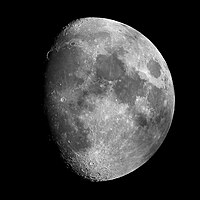
| ||
| Full Moon | 100% illuminated disc
|
Sunset to sunrise (all night) | 18:00 | 00:00 | 06:00 | 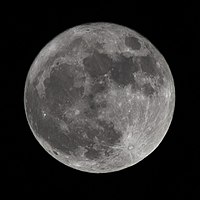
| |||
| Waning gibbous | Left side, (100%–50%) lit disc | Right side, (100%–50%) lit disc | Most of night and early morning | 21:00 | 03:00 | 09:00 | 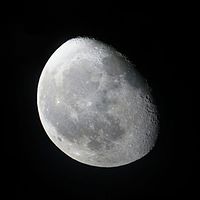
| ||
| Last quarter | Left side, 50.1% lit disc | Right side, 50.1% lit disc | Late night and morning | 00:00 | 06:00 | 12:00 | 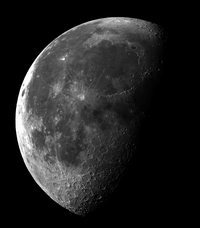
| ||
| Waning crescent | Left side, (50%–0%) lit disc | Right side, (50%–0%) lit disc | Pre-dawn to early afternoon | 03:00 | 09:00 | 15:00 | 
| ||
Waxing and waning[edit]
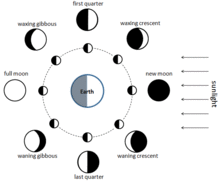
When the Sun and Moon are aligned on the same side of the Earth (conjunct), the Moon is "new", and the side of the Moon facing Earth is not illuminated by the Sun. As the Moon waxes (the amount of illuminated surface as seen from Earth increases), the lunar phases progress through the new moon, crescent moon, first-quarter moon, gibbous moon, and full moon phases. The Moon then wanes as it passes through the gibbous moon, third-quarter moon, and crescent moon phases, before returning back to new moon.
The terms old moon and new moon are not interchangeable. The "old moon" is a waning sliver (which eventually becomes undetectable to the naked eye) until the moment it aligns with the Sun and begins to wax, at which point it becomes new again.[4] Half moon is often used to mean the first- and third-quarter moons, while the term quarter refers to the extent of the Moon's cycle around the Earth, not its shape.
When an illuminated hemisphere is viewed from a certain angle, the portion of the illuminated area that is visible will have a two-dimensional shape as defined by the intersection of an ellipse and circle (in which the ellipse's major axis coincides with the circle's diameter). If the half-ellipse is convex with respect to the half-circle, then the shape will be gibbous (bulging outwards),[5] whereas if the half-ellipse is concave with respect to the half-circle, then the shape will be a crescent. When a crescent moon occurs, the phenomenon of earthshine may be apparent, where the night side of the Moon dimly reflects indirect sunlight reflected from Earth.[6]
Orientation by latitude[edit]

In the Northern Hemisphere, if the left side of the Moon is dark, then the bright part is thickening, and the Moon is described as waxing (shifting toward full moon). If the right side of the Moon is dark, then the bright part is thinning, and the Moon is described as waning (past full and shifting toward new moon). Assuming that the viewer is in the Northern Hemisphere, the right side of the Moon is the part that is always waxing. (That is, if the right side is dark, the Moon is becoming darker; if the right side is lit, the Moon is getting brighter.)
In the Southern Hemisphere, the Moon is observed from a perspective inverted, or rotated 180°, to that of the Northern and to all of the images in this article, so that the opposite sides appear to wax or wane.
Closer to the Equator, the lunar terminator will appear horizontal during the morning and evening. Since the above descriptions of the lunar phases only apply at middle or high latitudes, observers moving towards the tropics from northern or southern latitudes will see the Moon rotated anti-clockwise or clockwise with respect to the images in this article.
The lunar crescent can open upward or downward, with the "horns" of the crescent pointing up or down, respectively. When the Sun appears above the Moon in the sky, the crescent opens downward; when the Moon is above the Sun, the crescent opens upward. The crescent Moon is most clearly and brightly visible when the Sun is below the horizon, which implies that the Moon must be above the Sun, and the crescent must open upward. This is therefore the orientation in which the crescent Moon is most often seen from the tropics. The waxing and waning crescents look very similar. The waxing crescent appears in the western sky in the evening, and the waning crescent in the eastern sky in the morning.
Earthshine[edit]

When the Moon (seen from Earth) is a thin crescent, Earth (as viewed from the Moon) is almost fully lit by the Sun. Often, the dark side of the Moon is dimly illuminated by indirect sunlight reflected from Earth, but is bright enough to be easily visible from Earth. This phenomenon is called earthshine, sometimes picturesquely described as "the old moon in the new moon's arms" or "the new moon in the old moon's arms".
Timekeeping [edit]
Archaeologists have reconstructed methods of timekeeping that go back to prehistoric times, at least as old as the Neolithic. The natural units for timekeeping used by most historical societies are the day, the solar year and the lunation. The first crescent of the new moon provides a clear and regular marker in time and pure lunar calendars (such as the Islamic Hijri calendar) rely completely on this metric. The fact, however, that a year of twelve lunar months is ten or eleven days shorter than the solar year means that a lunar calendar drifts out of step with the seasons. Lunisolar calendars resolve this issue with a year of thirteen lunar months every few years, or by restarting the count at the first new (or full) moon after the winter solstice. The Sumerian calendar is the first recorded to have used the former method; Chinese calendar uses the latter, despite delaying its start until the second or even third new moon after the solstice. The Hindu calendar, also a lunisolar calendar, further divides the month into two fourteen day periods that mark the waxing moon and the waning moon.
The ancient Roman calendar was broadly a lunisolar one; on the decree of Julius Caesar in the first century BCE, Rome changed to a solar calendar of twelve months, each of a fixed number of days except in a leap year. This, the Julian calendar (slightly revised in 1582 to correct the leap year rule), is the basis for the Gregorian calendar that is almost exclusively the civil calendar in use worldwide today.
Calculating phase[edit]

Each of the four intermediate phases lasts approximately seven days (7.38 days on average), but varies ±11.25% due to lunar apogee and perigee.
The number of days counted from the time of the new moon is the Moon's "age". Each complete cycle of phases is called a "lunation".[7]
The approximate age of the Moon, and hence the approximate phase, can be calculated for any date by calculating the number of days since a known new moon (such as 1 January 1900 or 11 August 1999) and reducing this modulo 29.53059 days (the mean length of a synodic month).[8][d] The difference between two dates can be calculated by subtracting the Julian day number of one from that of the other, or there are simpler formulae giving (for instance) the number of days since 31 December 1899. However, this calculation assumes a perfectly circular orbit and makes no allowance for the time of day at which the new moon occurred and therefore may be incorrect by several hours. (It also becomes less accurate the larger the difference between the required date and the reference date). It is accurate enough to use in a novelty clock application showing lunar phase, but specialist usage taking account of lunar apogee and perigee requires a more elaborate calculation.
Effect of parallax[edit]
The Earth subtends an angle of about two degrees when seen from the Moon. This means that an observer on Earth who sees the Moon when it is close to the eastern horizon sees it from an angle that is about 2 degrees different from the line of sight of an observer who sees the Moon on the western horizon. The Moon moves about 12 degrees around its orbit per day, so, if these observers were stationary, they would see the phases of the Moon at times that differ by about one-sixth of a day, or 4 hours. But in reality, the observers are on the surface of the rotating Earth, so someone who sees the Moon on the eastern horizon at one moment sees it on the western horizon about 12 hours later. This adds an oscillation to the apparent progression of the lunar phases. They appear to occur more slowly when the Moon is high in the sky than when it is below the horizon. The Moon appears to move jerkily, and the phases do the same. The amplitude of this oscillation is never more than about four hours, which is a small fraction of a month. It does not have any obvious effect on the appearance of the Moon. It does however affect accurate calculations of the times of lunar phases.
Misconceptions[edit]
Orbital period[edit]
It can be confusing that the Moon's orbital sidereal period is 27.3 days while the phases complete a cycle once every 29.5 days (synodic period). This is due to the Earth's orbit around the Sun. The Moon orbits the Earth 13.4 times a year, but only passes between the Earth and Sun 12.4 times.
Eclipses[edit]
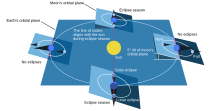
It might be expected that once every month, when the Moon passes between Earth and the Sun during a new moon, its shadow would fall on Earth causing a solar eclipse, but this does not happen every month. Nor is it true that during every full moon, the Earth's shadow falls on the Moon, causing a lunar eclipse. Solar and lunar eclipses are not observed every month because the plane of the Moon's orbit around the Earth is tilted by about 5° with respect to the plane of Earth's orbit around the Sun (the plane of the ecliptic). Thus, when new and full moons occur, the Moon usually lies to the north or south of a direct line through the Earth and Sun. Although an eclipse can only occur when the Moon is either new (solar) or full (lunar), it must also be positioned very near the intersection of Earth's orbital plane about the Sun and the Moon's orbital plane about the Earth (that is, at one of its nodes). This happens about twice per year, and so there are between four and seven eclipses in a calendar year. Most of these eclipses are partial; total eclipses of the Moon or Sun are less frequent.
See also[edit]
- Blue moon – Metaphor for a rare event, or lunar calendrical term
- Earth phase – Phases of the Earth as seen from the Moon
- Lunar effect – Unproven proposal of influence of lunar cycle on terrestrial creatures
- Lunar month – Time between successive new moons. (Also known as a "lunation".)
- Lunar observation – Methods and instruments used to observe the Moon
- Planetary phase – Part of planet seen to reflect sunlight
- Planetshine – Illumination by reflected sunlight from a planet
- Tide – Rise and fall of the sea level under astronomical gravitational influences
- Week – Time unit equal to seven days
- Month – Unit of time about as long the orbital period of the Moon
Footnotes[edit]
- ^ The quarter phases happen when the observer–Moon–Sun angle is 90°[citation needed], also known as quadrature[dubious ]. This is not the same as a right angle[dubious ], but the difference is very slight. /
- ^ Their durations vary slightly because the Moon's orbit is somewhat elliptical, so its orbital speed is not constant.
- ^ a b As with sunrise and sunset, there are seasonal variations in the time of moonrise and moonset.
- ^ Lunar months vary in length about the mean by up to seven hours in any given year. In 2001, the synodic months varied from 29d 19h 14m in January to 29d 07h 11m in July.[9]
References[edit]
Citations[edit]
- ^ "Is the 'full moon' merely a fallacy?". NBC News. 28 February 2004. Retrieved 2023-05-30.
- ^ Seidelmann 1992, p. 478.
- ^ "Hawaiian Moon Names". Imiloa, Hilo Attractions. Archived from the original on 2014-01-02. Retrieved 2013-07-08.
- ^ "Free Astronomy Lesson 7 - The Phases of the Moon". Archived from the original on 2023-04-14. Retrieved 2015-12-28.
- ^ "Gibbous Definition & Meaning". Dictionary.com. Archived from the original on 2023-04-21.
Origin of gibbous: 1350–1400; Middle English <Latin gibbōsus humped, equivalent to gibb(a) hump + -ōsus-ous
- ^ Asmelash & Allan 2019.
- ^ "Phases of the Moon and Percent of the Moon Illuminated". aa.usno.navy.mil. Archived from the original on 2018-02-06. Retrieved 2018-02-12.
- ^ Seidelmann 1992, p. 577.
- ^ "Length of the Synodic Month: 2001 to 2100". astropixels.com. 8 November 2019.
Sources[edit]
- Asmelash, Leah; Allan, David (30 July 2019). "A black moon is coming on July 31. Here's what that means". CNN.
- Buick, Tony; Pugh, Philip (2011). How to Photograph the Moon and Planets with Your Digital Camera. Springer. ISBN 978-1-4419-5828-0.
- Kelley, David H.; Milone, Eugene F. (2011). Exploring Ancient Skies: A Survey of Ancient and Cultural Astronomy (2nd ed.). Springer. ISBN 978-1-4419-7624-6.
- Kutner, Marc L. (2003). Astronomy: A Physical Perspective. Cambridge University Press. p. 435. ISBN 978-0-521-52927-3.
- Lynch, Mike. Texas Starwatch. Voyageur Press. ISBN 978-1-61060-511-3.
- Naylor, John (2002). Out of the Blue: A 24-Hour Skywatcher's Guide. Cambridge University Press. ISBN 978-0-521-80925-2.
- Ruggles, Clive L. N. (2005). Ancient Astronomy: An Encyclopedia of Cosmologies and Myth. ABC-CLIO. ISBN 978-1-85109-477-6.
- Seidelmann, P. Kenneth, ed. (1992). Explanatory Supplement to the Astronomical Almanac. Mill Valley: University Science Books.
External links[edit]
- Six Millennium Catalog of Phases of the Moon: Moon Phases from -1999 to +4000 (2000 BCE to 4000 CE).










